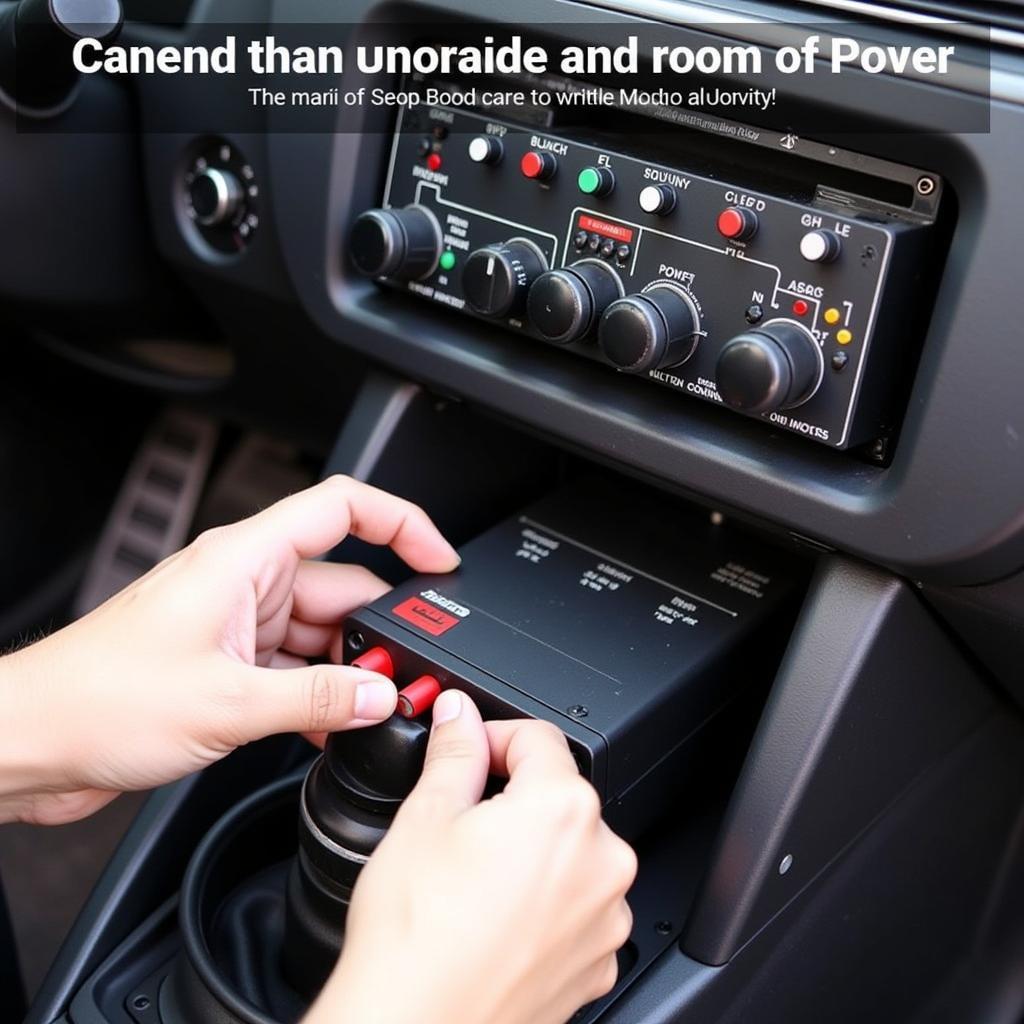Fixing a car amp can be a daunting task, but with the right knowledge and approach, you can often resolve the issue yourself. This comprehensive guide will walk you through common car amp problems, diagnostics, and repair solutions, helping you get your car audio system back on track.
After checking the basics like blown fuses and loose wiring, troubleshooting your car amp often involves using a multimeter to test various components. This allows you to isolate the problem and determine the necessary repairs. We’ll cover those steps in detail below. For more DIY car fixes, check out this cheap way to fix dent car.
Common Car Amp Problems and Solutions
Car amps can experience a range of issues, from simple connectivity problems to more complex internal failures. Here’s a breakdown of common problems:
Amp Not Turning On
- Check the Power: The first step is verifying the amp is receiving power. Check the power cable connection at the amp and the battery, ensuring they are secure. Also, inspect the fuse at the battery and the inline fuse near the amp.
- Ground Connection: A poor ground connection can prevent the amp from turning on. Ensure the ground wire is connected to a clean, bare metal surface on the car chassis.
- Remote Turn-On Wire: This wire triggers the amp to turn on when the car stereo is powered on. Check its connection to the head unit.
 Checking Car Amp Power Connections
Checking Car Amp Power Connections
Amp Turns On But No Sound
- Speaker Wire Connections: Verify that the speaker wires are correctly connected to both the amp and the speakers. Look for loose or frayed wires.
- Input Signal: Check the RCA cables connecting the head unit to the amp. A faulty cable or loose connection can prevent the audio signal from reaching the amp.
- Head Unit Settings: Ensure the head unit is configured correctly to send audio to the amp. Incorrect settings can mute the output to the amp.
Amp Making Distorted Sound
- Gain Settings: Improperly adjusted gain can cause distortion. Adjust the gain on the amp to match the output level of the head unit.
- Clipping: Clipping occurs when the amp is overdriven and produces a distorted signal. Reduce the gain or the volume to prevent clipping.
- Speaker Issues: Damaged or blown speakers can also cause distortion. Check the speakers for any visible damage or test them with a multimeter.
Amp Overheating
- Ventilation: Ensure the amp has adequate ventilation. It shouldn’t be enclosed in a tight space without airflow.
- Impedance Mismatch: Connecting speakers with an impedance lower than the amp’s recommended range can cause overheating. Verify the speaker impedance and ensure it’s compatible with the amp.
- Internal Fault: Overheating can also indicate an internal problem with the amp, such as a failing component.
Amp Goes Into Protect Mode
- Short Circuit: A short circuit in the speaker wires or within the amp itself can trigger protect mode. Inspect the speaker wires for any exposed wires or shorts.
- Overheating: As mentioned earlier, overheating can also activate protect mode. Address any ventilation or impedance issues.
- Internal Fault: A fault within the amp can also trigger protect mode. If you’ve ruled out other causes, professional repair may be necessary.
Diagnosing Car Amp Problems with a Multimeter
A multimeter is an essential tool for diagnosing car amp problems. Here’s how to use it:
- Check Power and Ground: Use the multimeter to verify voltage at the power and ground connections.
- Test Remote Turn-On Wire: Check for 12V on the remote turn-on wire when the head unit is powered on.
- Test Input Signal: Measure the voltage on the RCA inputs to confirm the amp is receiving a signal.
- Test Speaker Outputs: Check for continuity between the speaker output terminals and the speakers.
 Using a Multimeter to Test a Car Amp
Using a Multimeter to Test a Car Amp
When to Seek Professional Help
While many car amp problems can be resolved with basic troubleshooting, some issues require professional expertise. If you’ve exhausted all troubleshooting steps and the amp still isn’t working, it’s best to consult a qualified car audio technician. You can also consider a cheap way to fix chip car reddit for other car repairs. If you’re a senior on a fixed income and need a reliable car, explore the options for cars for seniors on fixed income near me.
Conclusion
Troubleshooting and fixing a car amp can be a rewarding experience. By understanding the common problems and using a systematic approach, you can often identify and resolve the issue yourself. However, don’t hesitate to seek professional help if you encounter a complex problem or aren’t comfortable working with electrical components.
For further assistance, connect with AutoTipPro at +1 (641) 206-8880 or visit our office at 500 N St Mary’s St, San Antonio, TX 78205, United States.





Leave a Reply